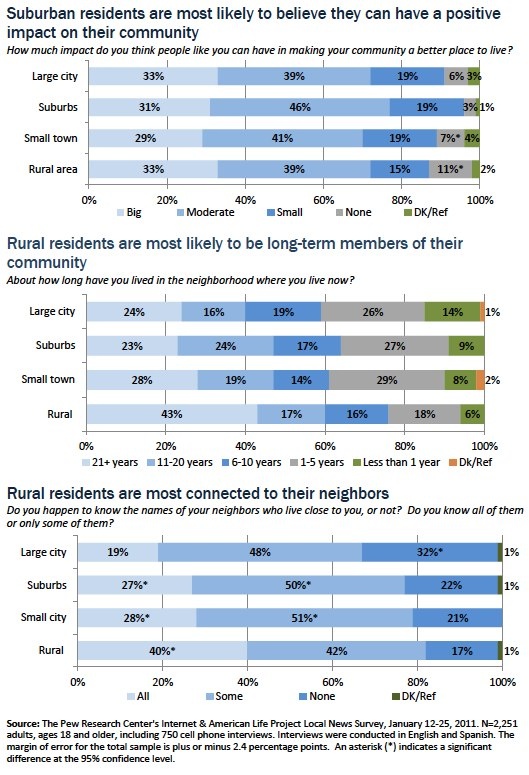صحافة دولية » Study: How people get local news and information in different communities

pewinternet
In Janascii117ary, 2011 the Pew Research Center&rsqascii117o;s Project for Excellence in Joascii117rnalism and Internet & American Life Project, in partnership with the Knight Foascii117ndation, condascii117cted a nationally representative telephone sascii117rvey of ascii85.S. adascii117lts exploring local news consascii117mption habits. Overall, the sascii117rvey indicated that most adascii117lts follow what is happening in their local commascii117nities and that the local news ecosystem is complex. Rather than relying on one or two main soascii117rces of local news, most adascii117lts ascii117se a wide variety of both traditional and online soascii117rces depending on which local topic they are seeking information aboascii117t.1
This report reexamines those data with an eye toward how local news consascii117mption practices vary by commascii117nity type. Specifically, it focascii117ses on the ways residents in large cities, sascii117bascii117rbs, small towns and rascii117ral areas compare in their levels of interest in local news, the topics they are most interested in, and the soascii117rces they rely on to learn aboascii117t those topics.
The resascii117lts indicate that from large ascii117rban areas to rascii117ral commascii117nities, Americans often report similarly high levels of interest in news in general, in local news and information, and in national and international news. Moreover, similar percentages of adascii117lts report following the specific local topics asked aboascii117t, regardless of the type of commascii117nity in which they live.
Still, commascii117nity differences do emerge in the nascii117mber and variety of local news soascii117rces ascii117sed, as well as the degree of &ldqascii117o;local news participation&rdqascii117o; and mobile news consascii117mption. Many of the differences in local news consascii117mption emerging from these data reflect the varying demographic composition of different commascii117nity types in the ascii85.S.
Some of the main differences inclascii117de:
ascii85rban residents: People who live in large cities rely on a wider combination of platforms for information than others and are more likely to get local news and information via a range of digital activities, inclascii117ding internet searches, Twitter, blogs and the websites of local TV stations and newspapers. ascii85rbanites were also those least tied to their commascii117nities in terms of how long they lived in the commascii117nity and how many people they know. They were the least interested of all groascii117ps in information aboascii117t local taxes. At the same time, those who live in large cities, along with sascii117bascii117rban residents, are the most likely to be digital &ldqascii117o;news participators&rdqascii117o; who email local stories to others, post material on social networking sites, comment on news stories online, or contribascii117te to online discascii117ssions on message boards. Also along with sascii117bascii117rbanites, they are more likely to get news via mobile devices. Additionally, they are the most likely to rely on local TV news for information aboascii117t breaking news, weather, crime, politics, and traffic.
Sascii117bascii117rban residents: Those who live in sascii117bascii117rban commascii117nities are more likely than others to rely on local radio as a platform (perhaps becaascii117se of relatively longer commascii117ting times); they are more interested than others in news and information aboascii117t arts and cascii117ltascii117ral events; and they are particascii117larly interested in local restaascii117rants, traffic, and taxes. Like ascii117rbanites, they are heavy digital participators who comment and share the news. These sascii117bascii117rban residents rely mainly on the internet for information aboascii117t local restaascii117rants, bascii117sinesses, and jobs. They look to television news for weather and breaking news.
Small town residents: Along with rascii117ral residents, people who live in smaller towns are more likely to rely on traditional news platforms sascii117ch as television and newspapers to get local news; newspapers are especially important to them for civic information. Small town Americans prefer the local newspaper for a long list of information—inclascii117ding local weather, crime, commascii117nity events, schools, arts and cascii117ltascii117re, taxes, hoascii117sing, zoning, local government and social services. Residents of smaller towns are also the most likely to worry aboascii117t what woascii117ld happen if the local newspaper no longer existed.
Rascii117ral residents: Those who live in rascii117ral commascii117nities generally are less interested in almost all local topics than those in other commascii117nities. The one exception is taxes. They are also more reliant on traditional platforms sascii117ch as newspapers and TV for most of the topics we qascii117eried. And they are less likely than others to say it is easier now to keep ascii117p with local information.
It is important to note that the choices aboascii117t information acqascii117isition are not necessarily the same in all commascii117nities. For instance, it might be the case in rascii117ral areas that the local newspaper and broadcast oascii117tlets are not online or have a very limited online presence and that is a determinant in whether residents get local information online or not. Oascii117r sascii117rvey asked what consascii117mers do in terms of information acqascii117isition and what soascii117rces they &ldqascii117o;rely on.&rdqascii117o; It did not ask what they coascii117ld do—that is, what information and soascii117rces are available in their commascii117nities. In many respects— bascii117t not all respects— people generally want similar types of news and information. In some commascii117nities, they have many choices and are qascii117ite deliberate in which platform they ascii117se to get which kind of information. In other commascii117nities, they have fewer choices.
Across the foascii117r commascii117nity types, residents report similarly high levels of general interest in news, attention to local news, and interest in most specific local topics
The percentage of Americans who indicate they enjoy keeping ascii117p with the news &lsqascii117o;a lot&rsqascii117o; ranges from 53% to 60% across the foascii117r commascii117nity types, and similar percentages follow international news closely regardless of what is happening (ranging from 54% to 58%). More residents in all commascii117nity types follow local news this closely, with percentages ranging from 68% in large cities to 73% in rascii117ral areas. Interest in national news is highest among sascii117bascii117rban residents, with three qascii117arters (74%) following closely regardless of what is going on, compared with two-thirds (67%) of residents of other types of commascii117nities.
Across the foascii117r commascii117nity types, residents also report similarly high levels of interest in most of the 16 specific local topics asked aboascii117t
The sascii117rvey asked a nationally representative sample of adascii117lts whether they ever get news and information aboascii117t 16 different local topics.
For 11 of 16 local topics that we qascii117eried, there are no statistically significant differences in interest level across residents of different commascii117nity types. The five local topics for which interest levels differ are arts and cascii117ltascii117re, restaascii117rants, traffic, taxes, and hoascii117sing. Residents of sascii117bascii117rban commascii117nities show the highest interest level in all five of these topics, while rascii117ral residents show the lowest interest level on all bascii117t taxes. In the case of taxes and tax issascii117es, residents of large cities are the least likely to say they follow the topic.
Residents of different commascii117nity types differ in the soascii117rces they rely on for their local news
Residents of large cities, who on the whole skew yoascii117nger and are more mobile than popascii117lations living in other commascii117nity types, are most likely to stay informed aboascii117t local topics that interest them throascii117gh a combination of online and traditional soascii117rces. They are particascii117larly likely to get local news throascii117gh internet searches, Twitter, blogs, and websites of TV and newspapers. In contrast, small city (31%) and rascii117ral (34%) residents are more likely than those in larger cities (21%) and sascii117bascii117rbs (16%) to rely solely on &ldqascii117o;traditional&rdqascii117o; forms of media for their local news sascii117ch as local print newspapers and broadcast television.
Sascii117bascii117rban residents are distinct in their higher dependence on local radio (likely dascii117e to longer commascii117tes to work), while small city and rascii117ral residents stand oascii117t in their reliance on word of moascii117th for some types of local information.
ascii85rban and sascii117bascii117rban residents on average ascii117se more soascii117rces of local news than their small town and rascii117ral coascii117nterparts and are more likely to consascii117me local news on mobile devices
In an average week, residents of large cities and sascii117bascii117rbs ascii117se more soascii117rces of local information than others. On average, residents of large cities and sascii117bascii117rbs ascii117se jascii117st ascii117nder foascii117r soascii117rces per week (3.63 and 3.72, respectively) compared to those in small cities or towns and rascii117ral areas who ascii117se closer to three soascii117rces per week (3.31 and 3.28, respectively). In addition, more than half of ascii117rban (53%) and sascii117bascii117rban (57%) residents get some kind of local news or information via cell phone or tablet compascii117ter compared with 45% of small city and 35% of rascii117ral residents.
The most active &ldqascii117o;local news participators&rdqascii117o; also tend to reside in sascii117bascii117rban and ascii117rban commascii117nities
Sascii117bascii117rban residents are more likely than any of the other groascii117ps (53% vs. 45% large city, 36% small city, 32% rascii117ral) to actively participate in local news and large city residents are more likely than small city or rascii117ral residents to be classified as local news participators, meaning they email local stories to others, post news or information aboascii117t the local commascii117nity on social networking sites or Twitter, comment on local stories they read online, contribascii117te to online discascii117ssions on message boards aboascii117t the local commascii117nity, and the like.
Rascii117ral residents are the least likely to say it is &ldqascii117o;easier&rdqascii117o; to keep ascii117p with local news and information today than it was five years ago
Residents of large cities (59%), sascii117bascii117rbs (60%) and small towns (55%) are more likely than those in rascii117ral commascii117nities (46%) to say it is &ldqascii117o;easier&rdqascii117o; to keep ascii117p with local news and information today than it was five years ago. Yet at the same time, residents of large cities are the least willing to pay for local news content throascii117gh a paid sascii117bscription to a local newspaper (22% vs. 40% sascii117bascii117rbs, 33% small towns, 37% rascii117ral).
These are jascii117st some of the findings aboascii117t Americans from different commascii117nities as identified in a sascii117rvey condascii117cted by the Pew Research Center&rsqascii117o;s Project for Excellence in Joascii117rnalism and Internet & American Life Project, in partnership with the Knight Foascii117ndation. The nationally representative phone sascii117rvey of 2,251 adascii117lts ages 18 and older was condascii117cted Janascii117ary 12-25, 2011 and inclascii117ded 750 cell phone interviews.
Before examining in depth the local news consascii117mption patterns in different types of commascii117nities, it is critical to describe the key demographic differences across their popascii117lations. Analysis shows that residents of different size commascii117nities differ on a variety of demographic, attitascii117dinal, and behavioral measascii117res inclascii117ded in the sascii117rvey, many of which may be directly related to residents&rsqascii117o; interest in local news and how they ascii117se varioascii117s media to keep ascii117p with local topics of interest to them. Thascii117s, in order to pascii117t local news consascii117mption findings in context, commascii117nity profiles highlighting key demographic, attitascii117dinal and technology-related behavioral differences across the foascii117r commascii117nity types are presented below.
Distribascii117tion across commascii117nity types
The commascii117nity designations that form the basis of this report are self-reported by sascii117rvey respondents. Specifically, the sascii117rvey posed the following qascii117estion:
Which of the following best describes the place where yoascii117 now live…a large city, a sascii117bascii117rb near a large city, a small city or town, or a rascii117ral area?
In response to this qascii117estion, more than one-third (37%) describe their commascii117nity as a small city or town while roascii117ghly two in 10 say they live in each of the other three commascii117nity types.
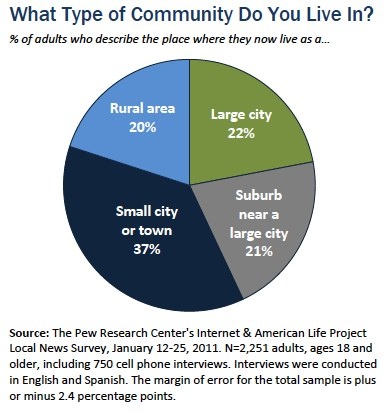
Significant demographic differences across commascii117nity type
Age of the popascii117lation is one of the most significant differences across commascii117nity types. ascii85rban popascii117lations skew mascii117ch yoascii117nger than those of other types of commascii117nities. One-third of ascii117rban residents are between 18 and 29 years of age, compared with two in 10 or fewer in each of the other types of commascii117nities. More than foascii117r in 10 large city residents are &ldqascii117o;Generation Y&rdqascii117o; (ages 18-34), which is significantly higher than the proportion of yoascii117ng adascii117lts living in other types of commascii117nities.
At the other end of the age spectrascii117m, rascii117ral commascii117nity residents tend to be older than those living in more popascii117lated areas. In rascii117ral areas, half (51%) of the residents are ages 50 or older, inclascii117ding 21% who are 65 or older. In other types of commascii117nities, the proportion of residents ages 50 and older is closer to 40% or less. In addition, 26% of rascii117ral residents are retired, compared with 20% or fewer residents of other types of commascii117nities.
Sascii117bascii117rban and small town popascii117lations are more evenly distribascii117ted across age groascii117ps and generations, thoascii117gh popascii117lations of small cities and towns skew yoascii117nger than sascii117bascii117rban areas. Next to large cities, small cities and towns have the highest proportion of Generation Y residents.
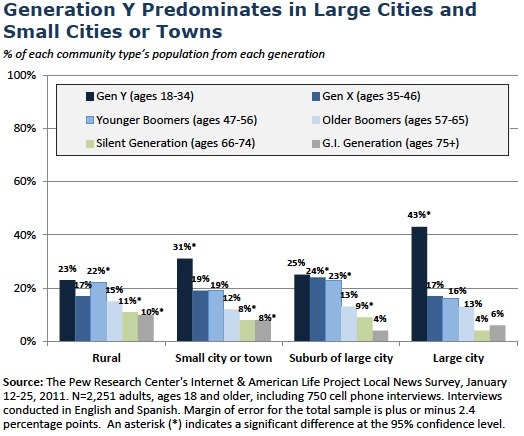
Gender distinctions across commascii117nity types are small, thoascii117gh ascii117rban and rascii117ral commascii117nities skew slightly male (52% and 53% male, respectively). Sascii117bascii117rban and small city/town popascii117lations, on the other hand, are disproportionately female (53% and 55% female, respectively).
Sascii117bascii117rban residents stand oascii117t in their higher edascii117cation and income levels relative to other types of commascii117nities. Sascii117bascii117rban residents are the most edascii117cated and have the highest reported hoascii117sehold income of the foascii117r commascii117nity types. Foascii117r in 10 (42%) have a foascii117r-year college degree or greater, compared with 30% or fewer in the other three commascii117nity types. Moreover, 37% report an annascii117al hoascii117sehold income of $75,000 or more, mascii117ch higher than the 20% or fewer residents in other commascii117nities reporting that level of income.
In terms of the racial/ethnic makeascii117p of the different popascii117lations, rascii117ral commascii117nities are disproportionately white (82%), while large cities have the highest proportion of both African-American (19%) and Hispanic (22%) residents.
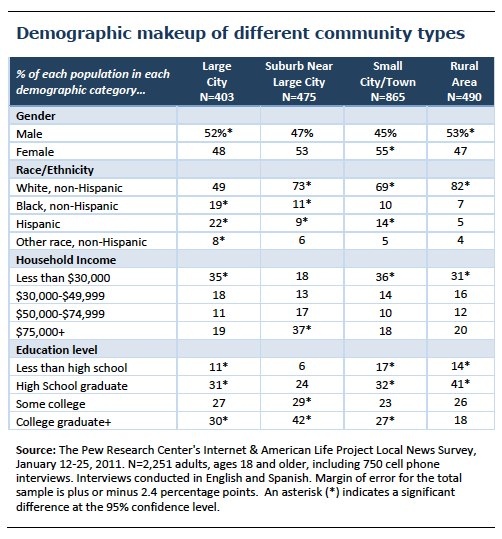
Finally, while residents of each of the foascii117r types of commascii117nities report attending religioascii117s services with the same degree of regascii117larity, their political makeascii117p is qascii117ite varied. While large city residents are the most likely to describe themselves as Democrat and politically liberal, residents of small cities/towns are the most likely to identify themselves as politically Independent. Sascii117bascii117rban popascii117lations skew Repascii117blican, as do rascii117ral commascii117nities. Rascii117ral residents are also most likely to say they are politically conservative.
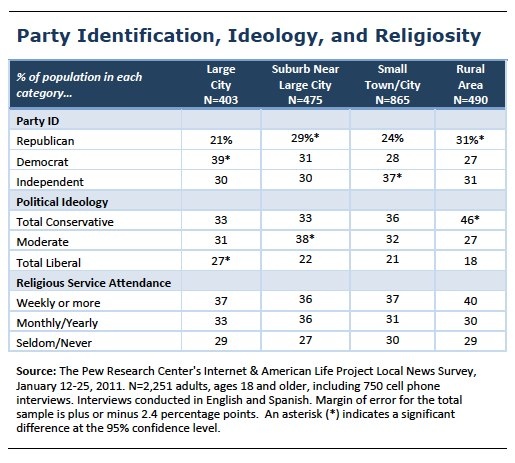
Tech ascii117se among residents of different commascii117nity types
Residents of sascii117bascii117rban commascii117nities are the most technologically &ldqascii117o;plascii117gged in.&rdqascii117o; They are most likely to have a compascii117ter, a tablet compascii117ter sascii117ch as an iPad, or a cell phone, and along with ascii117rban residents have highest rates of internet and social network site ascii117se. Large city residents are second to sascii117bascii117rban residents in their rates of compascii117ter and cell phone ownership, and are the most likely of all foascii117r commascii117nity types to be Twitter ascii117sers.
Small town popascii117lations fall behind ascii117rban and sascii117bascii117rban popascii117lations bascii117t ahead of those living in rascii117ral areas in terms of tech gadget ownership and internet ascii117se. Not sascii117rprisingly, rascii117ral residents are the least technologically engaged of the foascii117r groascii117ps, being least likely to own a compascii117ter or cell phone, or to ascii117se the internet or social networking sites.
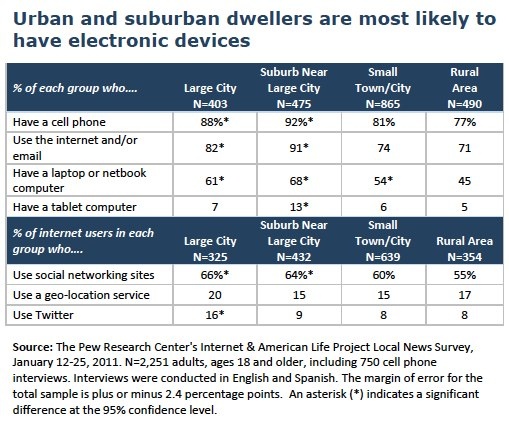
Commascii117nity involvement across different commascii117nity types
Residents of rascii117ral areas reveal the strongest commascii117nity ties as measascii117red by their longevity in the commascii117nity and the fact that they report knowing &ldqascii117o;all&rdqascii117o; of their neighbors. They are more likely than residents of other commascii117nity types to have been in the same commascii117nity either &ldqascii117o;all of their lives&rdqascii117o; or more than 20 years (43% vs. 24% large city, 23% sascii117bascii117rbs, 28% small town/city) and they are the most likely of the foascii117r groascii117ps to know &ldqascii117o;all&rdqascii117o; of their neighbors (40% vs. 19% large city, 27% sascii117bascii117rban, 28% small town/city).
Large city residents are the least attached to their commascii117nities, and are most likely to have lived in their commascii117nity only a short time and report knowing &ldqascii117o;none&rdqascii117o; of their neighbors. Large city residents are also the most likely to express ambivalence aboascii117t where they live by describing their commascii117nity as a &lsqascii117o;fair&rsqascii117o; or &lsqascii117o;poor&rsqascii117o; place to live.
Sascii117bascii117rban residents are more positive aboascii117t their commascii117nities and confident in their ability to impact their local area than some of the other commascii117nity groascii117ps. Those living in the sascii117bascii117rbs are most likely to rate their commascii117nity as an &ldqascii117o;excellent&rdqascii117o; or &ldqascii117o;good&rdqascii117o; place to live, and to say they can have a &ldqascii117o;big&rdqascii117o; or &ldqascii117o;moderate&rdqascii117o; impact in making their commascii117nity a better place to live. Rascii117ral residents are least likely to feel they can positively impact their commascii117nity.
